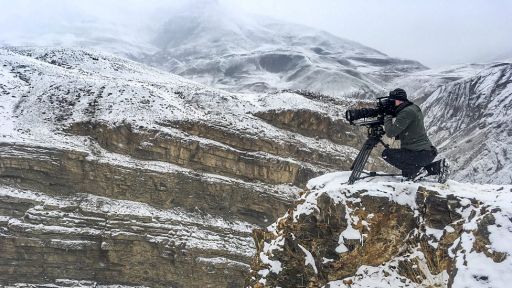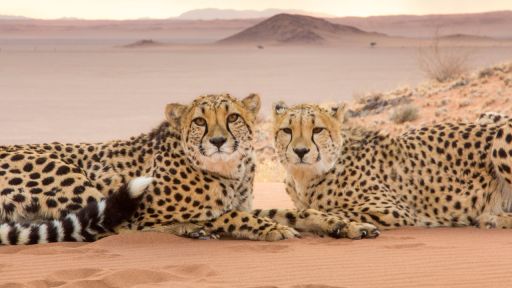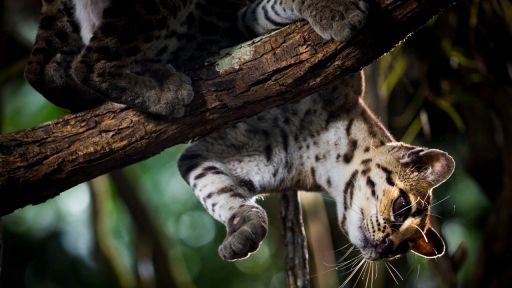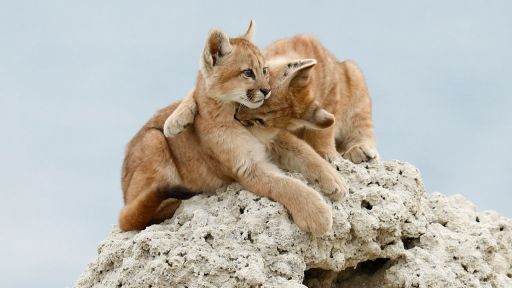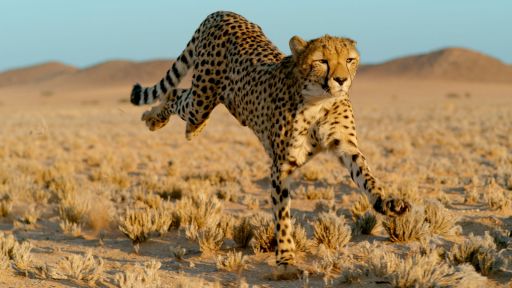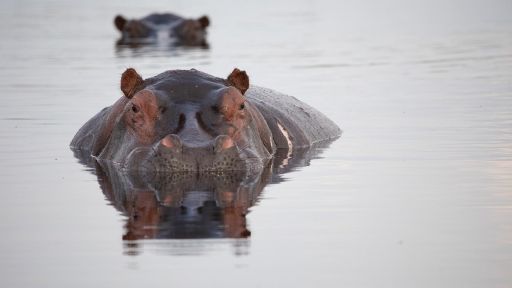TRANSCRIPT
♪♪ NARRATOR: From the iconic big cats that enthrall us... [ Snarls ] ♪♪ To the little-known small cats that are just coming into the light... this is a remarkable family of predators.
♪♪ They are super athletes... Super hunters... Possessing super senses.
Now, groundbreaking filming techniques and a surge in scientific research are revealing new facets of this amazing super family.
♪♪ [ Theme music playing ] ♪♪ ♪♪ ♪♪ NARRATOR: Dawn in the Namibian desert.
♪♪ ♪♪ Cheetahs are one of the few cats to form long-term coalitions with their siblings.
♪♪ For males, the relationship might be life-long.
They'll do everything together... ♪♪ even hunt.
♪♪ ♪♪ Few cats can resist a chase... but none give chase quite like a cheetah.
♪♪ ♪♪ ♪♪ The latest science tells us cheetahs rarely reach their record top speed.
So, if cheetahs don't rely simply on being fast, how do they catch their prey?
It's a question that requires a new perspective.
[ Cheetah growls ] This high-speed buggy is mounted with a stabilized slow-motion camera to give us the prey's-eye view.
♪♪ ♪♪ ♪♪ Their sprinting prowess is unrivaled.
♪♪ ♪♪ But this new approach reveals that there's far more to cheetahs than just straight line speed.
Cheetahs must not only keep up with their targets, but react to every twist and turn.
♪♪ Their blunt claws are running cleats that provide traction.
♪♪ Even at 50 miles an hour, the grip allows them to change direction, instantly... And their long tails whip around to keep them upright.
♪♪ ♪♪ They can also brake hard.
♪♪ Strong bones are shock absorbers, dissipating forces that could break a human leg.
♪♪ Cheetahs are more than just sprinters outrunning prey on open plains...
They're agile... and maneuverable.
They're elite athletes.
♪♪ ♪♪ And where that really counts is here, in woodland.
♪♪ This is an obstacle course where the prey's best chance is to weave and turn to escape.
♪♪ So a cheetah can rarely hit top speed.
♪♪ ♪♪ This chase is not a race...
It's a dance.
♪♪ The prey leads... ♪♪ and the predator must follow.
♪♪ ♪♪ ♪♪ ♪♪ Cheetahs are the fastest animals on land, incredible sprinters, but so much more.
♪♪ Even now, iconic cats like cheetahs can still surprise us.
♪♪ And there are other members of this extraordinary family about which we know even less.
♪♪ Hiding in this Sri Lankan jungle is a cat so rare, few have ever seen it.
♪♪ Exploring the world beyond his den for the first time is a miniature predator.
♪♪ ♪♪ The smallest feline in the world... A rusty spotted cat.
♪♪ [ Sniffing ] He may look like a kitten -- [ Mews ] He'd still fit in the palm of your hand.
But this little male is nearly full grown.
He'll soon be setting off on a solitary life, fending entirely for himself.
What he lacks in size, he makes up for in daring.
♪♪ ♪♪ Young cats are born curious -- it's how they learn about their world... ♪♪ Even if it can get them into trouble.
[ Branch creeks, cat mews ] Right away, he puts his super senses through their paces.
♪♪ ♪♪ His eyes are six times more powerful than our own and sensitive to the slightest movement.
♪♪ His whiskers, rooted in a bed of nerves, detect the faintest touch or the gentlest breath of wind.
[ Animal screeching ] His hearing is better than ours too... tuned to sounds that are completely imperceptible to the human ear.
[ Animals calling ] And his sense of smell is capable of distinguishing between a billion different odors.
[ Sniffing ] ♪♪ This little cat is alert to every change in his surroundings... ♪♪ But now it's time to learn which sounds... or sights... signal danger.
[ Mews ] ♪♪ ♪♪ Every step of today's adventure has been stored away in his memory.
He's building a 3-D map of the jungle in his head... ♪♪ so he can find his way home in a flash.
♪♪ All cats, from the smallest to the biggest, share extraordinary skills and abilities that have allowed them to conquer all four corners of the globe.
♪♪ Siberian tigers prowl frozen forests.
They are 200 times bigger than a rusty spotted cat... but just as elusive.
♪♪ In Brazil's Pantanal, the world's largest wetland, jaguars are on the hunt for monsters.
♪♪ ♪♪ For their size, they have the strongest bite of any cat... even making short work of huge caiman crocodiles.
♪♪ The jungle canopy of South and Central America is the realm of the tree climbing margay.
♪♪ They can judge distances perfectly... A critical skill if you're to clear a gap of 12 feet with a single leap, high above the forest floor.
♪♪ And when it's time to descend, their ankles rotate 180 degrees so they can walk vertically down.
♪♪ Whether it's hunting in the swamps of Asia... ♪♪ or patrolling the oldest desert in Africa... ♪♪ cats thrive everywhere.
♪♪ ♪♪ They've even conquered the highest mountains on Earth: the Himalayas.
♪♪ It's a place where food is scarce... ♪♪ So, to survive, you need a huge territory.
♪♪ ♪♪ This vast wilderness of sheer cliffs and bare rock is home to the snow leopard... the world's highest, and just maybe most lonesome cat.
♪♪ This aging male is searching... ♪♪ but not for food...
He's looking for a mate.
♪♪ ♪♪ The task would be nearly impossible if it wasn't for a cat's unique ability for long distance romance.
♪♪ His long-lasting and pungent spray carries his dating profile.
"Male, single, would like to meet."
♪♪ Both males and females spray, posting their romantic status to any and every one that passes by.
♪♪ So he diligently patrols these paths every day in the hope that a potential mate has passed through.
♪♪ At his most eager, he'll scent mark 20 times an hour.
♪♪ ♪♪ It may take a week or more to cover his entire territory, but his search must go on, day after day, in spite of the Himalayan weather.
♪♪ ♪♪ ♪♪ ♪♪ He checks for scent... then leaves his own.
♪♪ ♪♪ Here, he discovers a female has left her mark.
♪♪ Rubbing his own scent over hers, he declares his interest.
♪♪ ♪♪ ♪♪ This male might just have one last chance to mate.
♪♪ ♪♪ Could this be it?
♪♪ [ Distant yelping ] On the wind, the call of a distant female.
[ Distant yelping ] ♪♪ [ Distant yelping ] ♪♪ [ Distant yelping ] ♪♪ ♪♪ [ Nearby yelping ] Just maybe this male's search is over.
[ Yelping ] ♪♪ ♪♪ [ Continues yelping ] ♪♪ [ Yelping echoes ] For male cats, life is a lonely existence... ♪♪ But for females, it's very different.
♪♪ ♪♪ ♪♪ This is Honey... ♪♪ a female African leopard -- and a mother.
A radio collar is giving researchers an insight into the life of the most elusive of Africa's big cats.
♪♪ ♪♪ [ Roars ] ♪♪ Leopards thrive in more environments than any other cat, but that doesn't mean their lives are easy.
At 10 years old, Honey has outlived her brothers and sisters.
Somehow, she's survived a broken leg, and now, during the worst drought in decades, she's hunting for two.
[ Growls ] For mother cats, childcare is a balancing act between protection and provision.
♪♪ If they're to hunt successfully, a leopard must do so alone.
So she's left her young cub behind.
♪♪ A tail twitch -- Honey is on to something.
♪♪ ♪♪ The drought has withered all vegetation, so there's little cover.
She needs to get close -- within 12 feet -- to stand any chance of success... ♪♪ And anything could give the game away.
[ Birds clucking ] ♪♪ [ Clucking rapidly ] ♪♪ [ Clucking rapidly ] [ Snarls ] ♪♪ Foiled by Africa's most annoying alarm call.
♪♪ She might be empty-handed, but it's time to get back to her cub.
♪♪ It's been 36 hours since she left... and young cubs are prone to wander.
♪♪ [ Grunting ] ♪♪ Her calls are unanswered.
♪♪ Half of all leopard cubs don't survive their first year.
[ Grunting ] A cub's best chance is to stay hidden until she's sure it's safe.
[ Honey grunting ] ♪♪ Honey's youngster already has a leopard's knack for stealth.
She can even give her mother a surprise.
♪♪ ♪♪ ♪♪ For the last six months, she's grown strong on milk.
But now she's developing a cat's appetite for meat.
♪♪ ♪♪ ♪♪ A mother leopard always has a backup plan.
Honey has stashed a kill safely out of the reach of thieves.
♪♪ ♪♪ ♪♪ For her cub, this is an important lesson -- and the first of many.
Across the cat family, kittens and cubs have a long infancy.
It takes time to learn the skills needed to hunt for themselves.
♪♪ ♪♪ Often brothers and sisters are on hand for training.
♪♪ ♪♪ ♪♪ Play is the key to honing coordination... Building strength... And agility.
♪♪ The bond between them might endure for years, probably the closest relationship they'll ever have with another cat... ♪♪ But there is one life skill which they must master alone... ♪♪ The surprise attack.
[ Bird twitters ] ♪♪ [ Waves crashing ] [ Gulls crying ] Patagonia.
[ Waves crashing, birds calling ] An unforgiving wilderness where South America ends and the Antarctic begins.
[ Waves crashing, animals calling ] ♪♪ It's home to a secretive cat that can only survive here thanks to an eye for opportunity.
♪♪ ♪♪ Puma, the most southerly cat.
♪♪ [ Animals squawking ] ♪♪ [ Penguins squawking ] Once a year, these Magellanic penguins come ashore to nest... [ Penguins squawking ] ♪♪ a lifeline for a hungry cat.
♪♪ ♪♪ ♪♪ [ Squawking ] ♪♪ ♪♪ [ Penguin braying ] ♪♪ ♪♪ [ Penguin squawking ] ♪♪ This may seem ruthless, even callous, but pumas must take what's here today in case tomorrow it's gone.
♪♪ This is what it takes to survive in Patagonia.
♪♪ ♪♪ ♪♪ ♪♪ ♪♪ As night falls, more cats arrive.
♪♪ It's an extraordinary moment.
The abundance of prey means territorial boundaries are ignored, and, for now, these usually solitary creatures rub shoulders.
♪♪ It won't last.
♪♪ [ Waves crashing, penguins squawking ] The nesting season is soon over, and the penguins return to the sea.
♪♪ ♪♪ The cats move on.
♪♪ ♪♪ Thanks to their adaptability, they are the most widespread mammal in the Americas.
[ Birds calling ] ♪♪ At the other end of the continent, the planet's most northerly cats have chosen a very different path...
In a wintry wonderland with a record low of minus 80 degrees.
The Yukon is the coldest place in North America.
♪♪ This is Big Foot country.
But these prints belong to a very unusual cat... ♪♪ ♪♪ a Canada lynx... ♪♪ One whose high tech accessories are at last letting us in on a life almost impossible to observe.
[ Radio signal warbling ] ♪♪ This is L4 Zero, aka Kronk.
♪♪ Scientists and shaman agree, lynx are the keepers of secrets.
♪♪ You could spend years looking for a lynx and never see more than a footprint.
♪♪ And even if you did catch a glimpse of one, it would soon give you the slip.
♪♪ Until now.
Kronk's every move is tracked, offering insight into the world's ultimate game of cat and mouse -- or rather, cat and hare.
♪♪ ♪♪ Throughout these cold days, a lynx needs to eat often... ♪♪ And up here there's only one thing on the menu.
♪♪ Snowshoe hares.
In fact, a lynx's very survival depends on them.
♪♪ Helpfully, there's plenty around.
These hares breed like, well... rabbits.
♪♪ So it's just a matter of spotting one.
♪♪ ♪♪ Although Kronk seems to be oblivious, cats' eyes are fine-tuned for detecting movement... so his is a game of patience.
♪♪ ♪♪ ♪♪ ♪♪ ♪♪ To survive in these freezing conditions, Kronk must catch at least a hare every day... ♪♪ and use as little energy as possible doing it.
♪♪ ♪♪ If he can avoid a chase, he will.
♪♪ ♪♪ ♪♪ [ Grunting ] No cat is looking to make life any harder than it has to be.
For most cats, survival is a solitary endeavor...
But there is one famous exception.
Africa... Home to the King of Beasts.
♪♪ ♪♪ ♪♪ Lions may be legendary, but among cats they're strange.
That's because they're the only ones who live together, the only truly social cat.
♪♪ The pride is a family and an alliance.
♪♪ ♪♪ ♪♪ ♪♪ ♪♪ Ruaha National Park, Tanzania.
Here they're famous for forming super prides -- huge groups can tackle the most formidable prey in Africa.
In the dry season, lions come together to defend riverbeds... ♪♪ where they need only wait for thirsty prey to come to them.
♪♪ In numbers, lions find the strength and audacity to face Africa's giants.
♪♪ But once they're discovered, their chance has gone.
It won't be long before another comes their way.
[ Buffalo grunting ] This buffalo herd is hundreds strong.
Each one weighs more than three lions combined.
♪♪ And they fight back.
♪♪ ♪♪ Lions suffer more injuries and fatalities from buffalo than from any other adversary.
♪♪ ♪♪ [ Birdsong ] ♪♪ This female is nursing three cubs... [ Cubs whimpering ] And also a serious wound inflicted by a buffalo.
♪♪ ♪♪ A debilitating injury like this is not just painful...
It's potentially life threatening for both her and her cubs.
♪♪ ♪♪ They are all hungry.
♪♪ ♪♪ ♪♪ ♪♪ ♪♪ ♪♪ On her own, this is hopeless.
♪♪ But she's not alone... She's part of the pride.
♪♪ ♪♪ ♪♪ [ Grunting ] [ Roaring ] ♪♪ [ Lions roaring ] ♪♪ ♪♪ ♪♪ ♪♪ ♪♪ No other cat can bring down a colossus like this.
♪♪ And now she will be able to feed her family and allow her wounds to heal.
Living in a pride sets lions apart.
It's an extraordinary alliance, but it's not just about big game hunting... ♪♪ This is an extended family that supports and protects every mother and her cubs.
♪♪ That makes lions, surely, the most extraordinary members of a remarkable animal family.
♪♪ Next time... the most secretive cats with surprising lives.
Living in the world's most remote and unexpected places.
Discover how cats have conquered the planet.
♪♪ -"Nature's" three-part series continues, from the oldest desert in Africa to the highest mountain on Earth, cats are leading extraordinary lives.
They are acrobats in the jungle... and opportunists on the beach... big or small, cats have conquered the planet.
♪♪ ♪♪ ♪♪ ♪♪ ♪♪ ♪♪ To learn more about what you've seen on this "Nature" program, visit pbs.org.
♪♪ ♪♪



